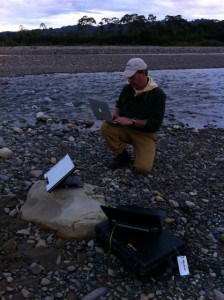Working in the creature-infested and disease-prone Amazon jungle is not all just fun and games – no indeed – someone might get hurt (just as they might at a less remote worksite).
And that is what companies such as Medcor are for.
Founded in 1984, Medcor operates more than 170 non-traditional clinics located on-site in client locations around the United States. Medcor’s staff, systems, and software in these clinics help employers control costs, improve outcomes, provide rapid access to medical care when necessary and avoid claims when they are not necessary. This means planning ahead, even when the worksite is very different from the typical office.
Privately held with 400 full-time and 400 part-time employees, Medcor does $54 million in business per year, and claims to save its clients several hundred million in workers compensation and general health care costs every year. In addition to its on-site clinics, the company provides telephonic injury triage to more than 80,000 triage worksites from a wide variety of industries across the US.
Click Link to Access Free PDF Download
“The 6-Step Process To Determine Workers’ Comp Injury Causation”
Although its core business is focused on providing on-site medical clinics to large worksites and providing injury triage to small worksites across the country, Medcor has a great deal of expertise in the fascinating field of wilderness medicine.
The company provides on-site medical services at Yellowstone National Park, supports a clinic at the base camp of Mount Everest, and has provides medical services to remote projects such as oil pipelines, windfarms, and highway construction. The company has provided medical support to government projects on Kwajalein and Midway Island in the pacific ocean. Medcor has also has served those affected by hurricanes Katrina and Rita, and provided on-site medical services at the World Trade Center after 9-11. Medcor is currently deployed helping the flood relief efforts in Minot, ND.
Currently, Medcor is working for the Zoological Society of San Diego. The society hired Medcor, to establish a wilderness medical program to support a research station in the jungle, at Cocha Chashu in the Amazon jungle of Peru. Zoo officials asked Medcor to help assess the medical needs and response options for people at the station as it is very remote, requiring four days travel from the U.S., the last two being by small boats 10 hours a day.
The zoo is assessing the risks to the participants — zoo employees or visitors — and planning to provide for the safety of everyone there. These goals include providing medical services to the program.
Executive Vice President Curtis Smith says there are many challenges to such a remote project.
First, he says, most medical providers are trained and experienced to work within a broader system. Here, there is a 911 system to call in emergencies, there are specialists to refer to or to consult with by phone. In the US, X-ray, lab, and other diagnostic tools are readily available, and well-stocked pharmacies exist nearby. If on-site clinic staff in the US rely on those off-site resources too much, they negate many of the benefits of resolving cases on site, avoiding unnecessary claims, and reducing costs, Smith says.
If they rely on those systems in remote locations, they are really in trouble, Smith says. Clinics operating in remote locations cannot rely on traditional off-site resources, forcing the on-site staff to be self-reliant. Those efficiencies help Medcor’s on-site clinics perform better back in the U.S.
13 common challenges to setting up a remote medical clinic include:
- Recognizing the hazards and limitations of the area.
- Determining a scope of care that minimizes risks and costs – then writing standards and protocols to match.
- Figuring out the logistics of getting there and back routinely, and during medical emergencies..
- Determining the equipment and supplies that are truly needed and what is extraneous.
- Developing practical reliable emergency plans based on the logistics, staff, and supplies that are available.
- Establishing the method, reliability, security, and cost of various communication methods.
- Selecting the right staff – not only in terms of medical skill and experience, but with the personality to get along with the client team at the remote site, and the character to function independently.
- Training the staff in advance of deployment so they are not learning the basics, such as equipment, software and procedures, on the job. The on-site staff will have to learn the specifics of each site once there, which will be tough enough.
- Handling turnover – in the event that the medical staff leaves, for whatever reason.
- Finding valuable and rewarding work for the medical staff to do when not treating patients so the staff stays engaged and motivated to remain on the project.
- Establishing clear goals with clients – often they, too, do not understand everything about the remote site.
- Language barriers between the employees and local medical providers, if not English speaking, need to be addressed.
Another common challenge to setting up remote clinics is being underbid by people who grossly under estimate the work involved and resources needed.
Each site and project can be very different from others. Long-term assignments are very difficult to staff because the medical personnel miss their families, friends, and “professional life,” Smith says. Short term assignments are difficult because they interrupt or prevent long term work elsewhere.
Author Rebecca Shafer, JD, President of Amaxx Risks Solutions, Inc. is a national expert in the field of workers compensation. She is a writer, speaker, and website publisher. Her expertise is working with employers to reduce workers compensation costs, and her clients include airlines, healthcare, printing, publishing, pharmaceuticals, retail, hospitality, and manufacturing. See www.LowerWC.com for more information. Contact: RShafer@ReduceYourWorkersComp.com.
Our WC Book: http://www.wcmanual.com
WORK COMP CALCULATOR: http://www.LowerWC.com/calculator.php
MODIFIED DUTY CALCULATOR: http://www.LowerWC.com/transitional-duty-cost-calculator.php
WC GROUP: http://www.linkedin.com/groups?homeNewMember=&gid=1922050/
SUBSCRIBE: Workers Comp Resource Center Newsletter
©2011 Amaxx Risk Solutions, Inc. All rights reserved under International Copyright Law. If you would like permission to reprint this material, contact Info@ReduceYourWorkersComp.com.
















Appears to me that what you do is about as good as it gets.
…and, you make it look easy. thank you!